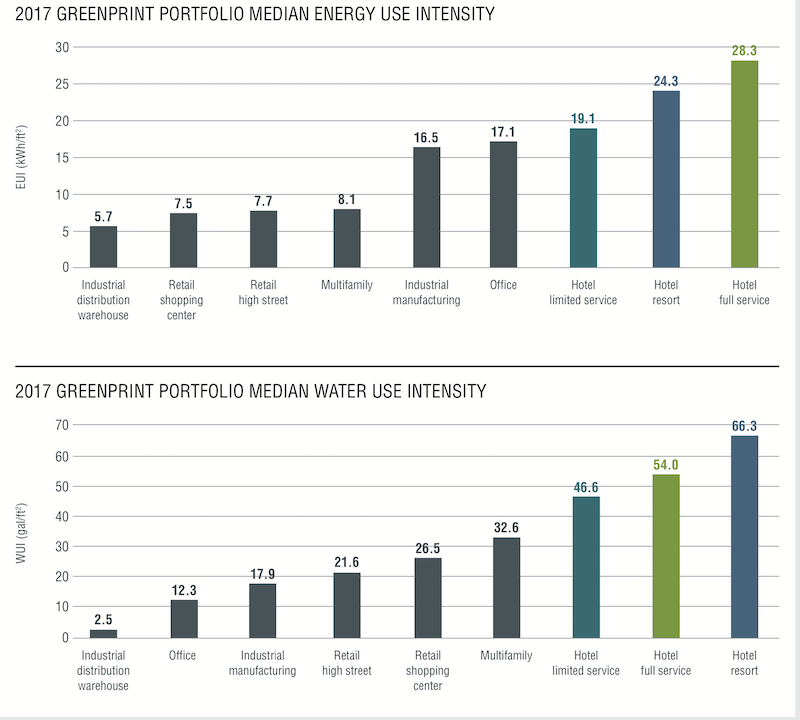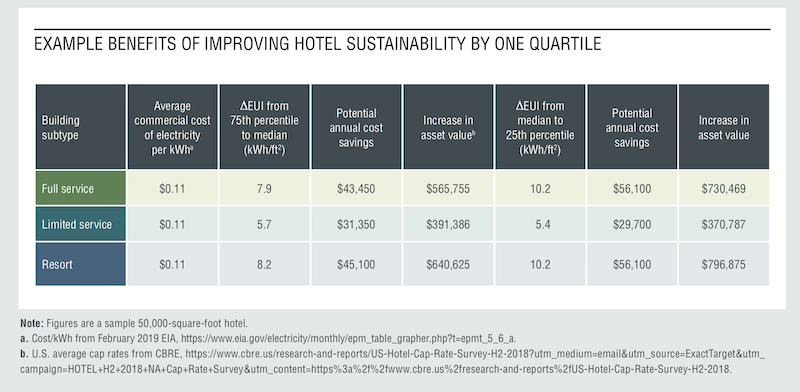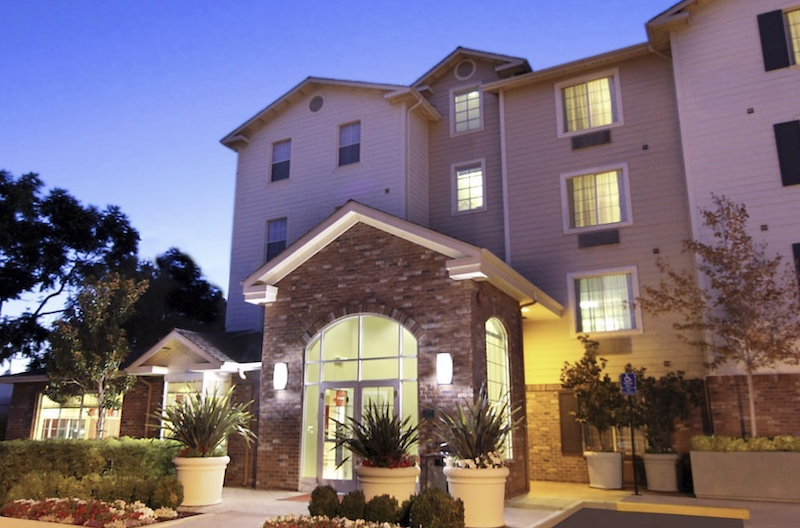A new report about Sustainability in Hotels finds the hospitality industry is still consuming more energy and water than most other commercial and residential sectors. The report, from the Urban Land Institute Greenprint Center for Building Performance, also identifies ways that hotels are becoming more sustainable, and singles out examples of hotels that have taken the necessary steps to reduce their environmental footprint.
The global hotel industry comprises about 184,000 hotels containing almost 17 million rooms, a number that has increased 17.7% from 2008 to 2018.
Of commercial buildings, hotels are among the highest energy and water users per sf (see chart below). The United Nations World Tourism Organization estimates that hotels account for about 1% of global greenhouse gas emissions, a number that is only expected to increase as the industry continues to experience growth and demand. To stay within the 2-degree Celsius threshold for temperature increase agreed upon by the Paris Climate Accord, the hospitality industry would need to reduce emissions 66% by 2030 and 90% by 2050.
The report states that opportunities to improve energy, water, and waste efficiency are widely available for hotels of all types, through operational changes such as utility benchmarking and temperature setpoint adjustments, as well as technical updates like high-efficiency water fixtures or LED lighting installations.
Investments in high-efficiency energy management systems, HVAC retrofits, or on-site renewable energy, require longer project planning and more overall effort. Achieving projects of this magnitude requires collaboration between owners and operators, but can pay long-term dividends for hotels in utility savings and guest comfort.
OPERATING INCOME IS DRIVING SUSTAINABILITY
According to a recent survey of 72,000 Hilton guests, around one third said they prefer hotels with environmental and social programs. Among guests younger than 25, that number jumped to 44%.
Last week, Bee + Hive, a not-for-profit association that unites hotels and partners committed to sustainable tourism, launched a booking platform that will give travelers the ability to plan a vacation based on sustainable experiences.
“Sustainable design is what the market wants,” says W. Edward Walter, ULI’s Global CEO. “Younger and older generations place a high priority on green and sustainable development in how and where they live, work, and play. It’s also what cities need, as they seek to become more resilient, competitive, and livable.”
That being said, the report indicates that the biggest driver of sustainability initiatives in the hotel sector is the potential to improve an asset’s net operating income. “Hotels are a unique asset in that they reap all utility savings from sustainability projects directly to their bottom line, without having to share those savings with tenants.”
In the U.S., hotels in many cities are subject to mandatory utility benchmarking and other building-focused sustainability legislation. New York City’s new building emissions legislation, passed in April 2019, sets carbon dioxide equivalent (CO2e) emissions targets for all building types (for hotels: 9.87 CO2e per sf by 2024 and 5.26 CO2e per sf by 2030).
Many U.S. cities have developed incentives for real estate to “go green” that apply to hotel properties. In Nashville, developments that achieve LEED certification (or another green certification) in the central business district can obtain a density bonus that scales with the stringency of the certification.
Even without sustainability requirements, sustainable features are a strong way to ease community concerns about development, decreasing time spent on approvals and improving project viability. many in the hotel industry have set internal goals for reducing their impact on the environment.

By comparison to other building types, hotels are energy and water hogs, based on the Cornell Hotel Sustainability Benchmarking Index, with which Urban Land Institute has partnered since 2016. Chart: ULI
CASE STUDIES SHOW THE WAY
Hospitality organizations are setting science-based targets for their sustainability goals. In 2019, nine companies, including MGM Resorts International, Hersha Hospitality Trust, and Wyndham Worldwide have committed to setting these targets, and seven—including Hilton, Host Hotels, and Las Vegas Sands—have already had their targets set and approved.
Hilton is committed to cutting emissions 61% by 2030, and Marriott is committed to reduce carbon intensity 30% by 2025.
Hersha, which operates 48 hotels with 7,644 rooms, is cited in the ULI report for its rollout of LED lighting and guest room energy management systems that has saved Hersha’s hotels over $1.5 million annually in utility costs with under 2.5-year payback periods. A more recent rollout of efficiency technology for laundry has reduced Hersha’s water use for laundry by 70-80%. All told, Hersha has reduced its energy use per sf by 15%, its greenhouse gas emissions per sf by 41%, and has diverted 25% of its waste from landfills, saving $11 million since 2010 and creating $65 million additional portfolio value.
Water use in hotels accounts for about 24% of total utility expenses and 15% of total water use in commercial and institutional real estate in the United States. To reduce its intensity, the 23-story 308-room MGM National Harbor Resort & Casino in Maryland, which opened in 2016, installed high-efficiency fixtures that save more than 34 million gallons each year. The hotel’s roof is designed specifically to capture rainwater that is then treated and stored in a 700,000-gallon water cistern. That water is used for irrigation and toilet flushing.
These water efficiency efforts are part of a larger environmentally conscious design strategy at MGM National Harbor, including one of the largest privately operated combined heat and power plants in the Washington, D.C., region.
Sustainability includes environmental stewardship. As part of the high-quality guest experience they want to provide, resorts are protecting their surrounding natural environment and biodiversity. The ULI report points specifically to Terranea Resort, in Rancho Palos Verdes, Calif., which occupies only 25% of its 102-acre site, and conserves 75 acres for natural landscape. Stormwater is channeled through a series of wet ponds and vegetated wetland channels called bioswales for natural irrigation and water treatment, enhancing water quality while serving as a habitat for native avian species.

Savings from sustainable programs can increase the hotel property's value. Chart: ULI
BEST PRACTICES EMPHASIZE DATA SHARING
The ULI report laments, however, that these and other case studies are not more the rule than exceptions to it. It notes that hotels continue to lag in sustainability because owner and operator models create challenges to scale solutions. The lack of data and verification also inhibits future sustainable opportunities. And many hotels still aren’t balancing their sustainability initiatives with their guests’ expectations.
The report offers sustainability best practices for hotels that include:
•Consider sustainability during project design
•Incorporate sustainability into renovations
•Select AEC managers and stakeholders with sustainability expertise
•Collect and analyze energy, water, and waste data to track performance
•Owners and operators should work together to align goals and maintain communication
•Develop the hotel workforce
•Identify partner organizations that can support sustainability programs.
These best practices are likely to be affected, and possibly altered, by trends that are shaping the hospitality sector, such as modular construction, sustainable materials selection, smart-room technology, and a heightened focus on health and wellness.
Related Stories
Sustainability | Aug 15, 2023
Carbon management platform offers free carbon emissions assessment for NYC buildings
nZero, developer of a real-time carbon accounting and management platform, is offering free carbon emissions assessments for buildings in New York City. The offer is intended to help building owners prepare for the city’s upcoming Local Law 97 reporting requirements and compliance. This law will soon assess monetary fines for buildings with emissions that are in non-compliance.
Hotel Facilities | Aug 2, 2023
Top 5 markets for hotel construction
According to the United States Construction Pipeline Trend Report by Lodging Econometrics (LE) for Q2 2023, the five markets with the largest hotel construction pipelines are Dallas with a record-high 184 projects/21,501 rooms, Atlanta with 141 projects/17,993 rooms, Phoenix with 119 projects/16,107 rooms, Nashville with 116 projects/15,346 rooms, and Los Angeles with 112 projects/17,797 rooms.
Market Data | Aug 1, 2023
Nonresidential construction spending increases slightly in June
National nonresidential construction spending increased 0.1% in June, according to an Associated Builders and Contractors analysis of data published today by the U.S. Census Bureau. Spending is up 18% over the past 12 months. On a seasonally adjusted annualized basis, nonresidential spending totaled $1.07 trillion in June.
Hotel Facilities | Jul 27, 2023
U.S. hotel construction pipeline remains steady with 5,572 projects in the works
The hotel construction pipeline grew incrementally in Q2 2023 as developers and franchise companies push through short-term challenges while envisioning long-term prospects, according to Lodging Econometrics.
Adaptive Reuse | Jul 27, 2023
Number of U.S. adaptive reuse projects jumps to 122,000 from 77,000
The number of adaptive reuse projects in the pipeline grew to a record 122,000 in 2023 from 77,000 registered last year, according to RentCafe’s annual Adaptive Reuse Report. Of the 122,000 apartments currently undergoing conversion, 45,000 are the result of office repurposing, representing 37% of the total, followed by hotels (23% of future projects).
Hotel Facilities | Jul 26, 2023
Hospitality building construction costs for 2023
Data from Gordian breaks down the average cost per square foot for 15-story hotels, restaurants, fast food restaurants, and movie theaters across 10 U.S. cities: Boston, Chicago, Las Vegas, Los Angeles, Miami, New Orleans, New York, Phoenix, Seattle, and Washington, D.C.
Market Data | Jul 24, 2023
Leading economists call for 2% increase in building construction spending in 2024
Following a 19.7% surge in spending for commercial, institutional, and industrial buildings in 2023, leading construction industry economists expect spending growth to come back to earth in 2024, according to the July 2023 AIA Consensus Construction Forecast Panel.
Hotel Facilities | Jul 21, 2023
In Phoenix, a former motel transforms into a boutique hotel with a midcentury vibe
The Egyptian Motor Hotel’s 48 guest rooms come with midcentury furnishings ranging from egg chairs to Bluetooth speakers that look like Marshall amplifiers.
Sponsored | Fire and Life Safety | Jul 12, 2023
Fire safety considerations for cantilevered buildings [AIA course]
Bold cantilevered designs are prevalent today, as developers and architects strive to maximize space, views, and natural light in buildings. Cantilevered structures, however, present a host of challenges for building teams, according to José R. Rivera, PE, Associate Principal and Director of Plumbing and Fire Protection with Lilker.
Standards | Jun 26, 2023
New Wi-Fi standard boosts indoor navigation, tracking accuracy in buildings
The recently released Wi-Fi standard, IEEE 802.11az enables more refined and accurate indoor location capabilities. As technology manufacturers incorporate the new standard in various devices, it will enable buildings, including malls, arenas, and stadiums, to provide new wayfinding and tracking features.

















